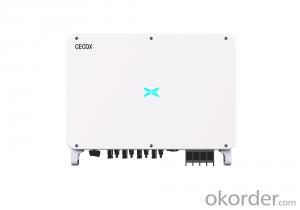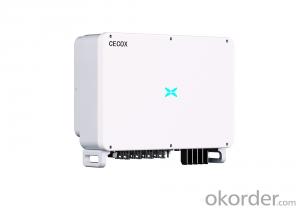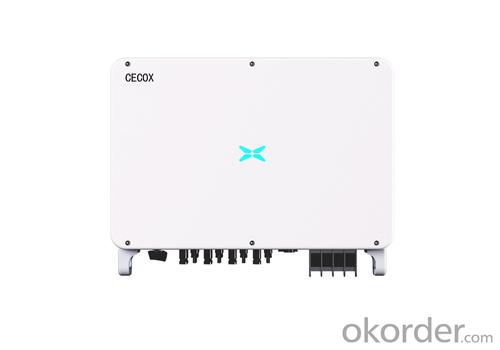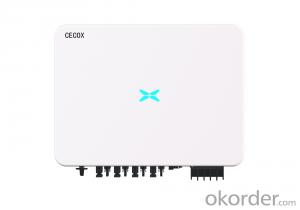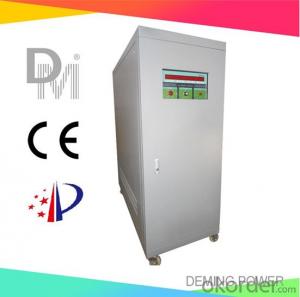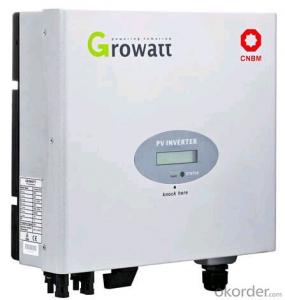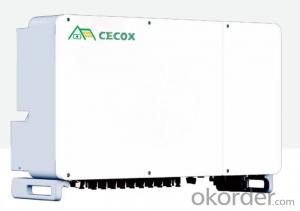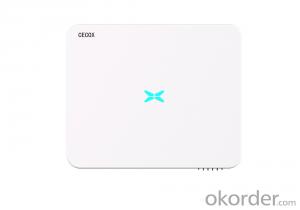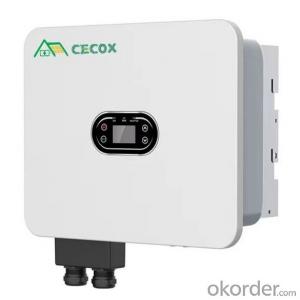3kVA Solar Inverter - 50kw 60kw 66kw 70kw Three Phase On-Grid Solar Inverter
- Loading Port:
- SHENZHEN
- Payment Terms:
- TT OR LC
- Min Order Qty:
- 30 unit
- Supply Capability:
- 500 unit/month
OKorder Service Pledge
OKorder Financial Service
You Might Also Like
Specification
XG50kW-70kW
Three Phase On-Grid Solar Inverter
XG50KTR | XG50KTRL | XG60KTR | XG60KTRL | XG66KTRL | XG70KTRL | |
Input(DC) | ||||||
Max. Input Power | 80 kW | 96 kW | 105.6kW | 112kW | ||
Max. Input Voltage | 1100V | |||||
Start Voltage | 250V | |||||
Rated Input Voltage | 600V | 700V | ||||
Full-load MPP Voltage Range | 520V-850V | 600V-850V | ||||
MPPT Voltage Range | 200V-1000V | |||||
Number of MPP Trackers | 4 | |||||
Number of string per MPPT | 3/2/3/2 | 3/3/3/3 | ||||
Max.Current per MPPT | 39A/26A/39A/26A | 39A | ||||
Max.Short Circuit Current per MPPT | 48A/32A/48A/32A | 48A | ||||
Output(AC) | ||||||
Max. Output Current | 79.7 A | 66.2 A | 95.6 A | 79.4 A | 87.4A | 96.2A |
Rated Output Power | 50 kW | 60 kW | 66kW | 70kW | ||
Max. Output Power | 55 kVA | 66kVA | 72.6kVA | 77kVA | ||
Rated Grid Frequency | 50 Hz / 60 Hz | |||||
Rated Grid Voltage | 230Vac / 400Vac | 277Vac / 480Vac | 230Vac / 400Vac | 277Vac/480Vac | ||
Power Factor | >0.99 (0.8 leading~0.8 lagging) | |||||
THDi | <3% (Rated Power) | |||||
Efficiency | ||||||
Max. Efficiency | 98.70% | 98.80% | ||||
European Efficiency | 98.40% | 98.50% | ||||
MPPT Efficiency | 99.90% | |||||
Protection | ||||||
DC reverse polarity protection | Yes | |||||
Anti-Islanding protection | Yes | |||||
AC short circuit protection | Yes | |||||
Residual current monitoring unit | Yes | |||||
Insulation resistance monitoring | Yes | |||||
Ground fault monitoring | Yes | |||||
Grid monitoring | Yes | |||||
PV string monitoring | Yes | |||||
Surge protection | Type II | |||||
AFCI protection | Optional | |||||
Communication | ||||||
Display | LED / LCD / WiFi+App | |||||
Communication | Standard:RS485 Optional:WiFi / GPRS / Ethernet | |||||
Standard Compliance | ||||||
Grid Connection Standards | IEC 61727, IEC 62116, IEC 60068, IEC 61683, VDE-AR-N 4110:2018, VDE-AR-N 4105:2018, VDE-AR-N 4120:2018, EN 50549, AS/NZS 4777.2:2020, CEI 0-21, VDE 0126-1-1/A1 VFR2014, UTE C15-712-1:2013, DEWA DRRG, NRS 097-2-1, MEA/PEA, C10/11, G98/G99 | |||||
Safety/EMC | IEC 62109-1:2010, IEC 62109-2:2011, EN 61000-6-2:2005, EN 61000-6-3:2007/A1:2011 | |||||
General Data | ||||||
Dimensions (W*H*D) | 650 x 450 x 260 mm | |||||
Weight | 50 kg | |||||
Operating Temperature Range | -30° C ~ +60° C | |||||
Cooling Method | Smart Cooling | |||||
Protection Degree | IP66 | |||||
Max. Operating Altitude | 4000 m | |||||
Relative Humidity | 0 ~ 100% | |||||
Topology | Transformerless | |||||
Night Power Consumption | < 1 W | |||||
MARKETING & SERVICE NETWORK
CNBM global sales team provides customers with professional and efficient pre-sale,
in sale and after-sale services, and enhances the added value of the brand with high-quality services.
Products Details:
High voltage protection Over load protection
Battery reverse connected protection Dust-proof
Low voltage protection Overheating protection
Output short-circuit protection Insect prevention
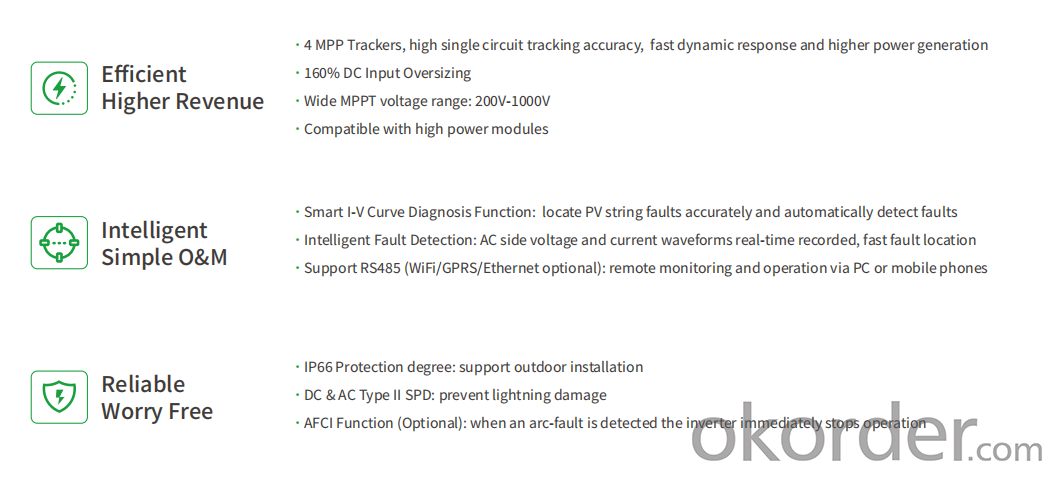
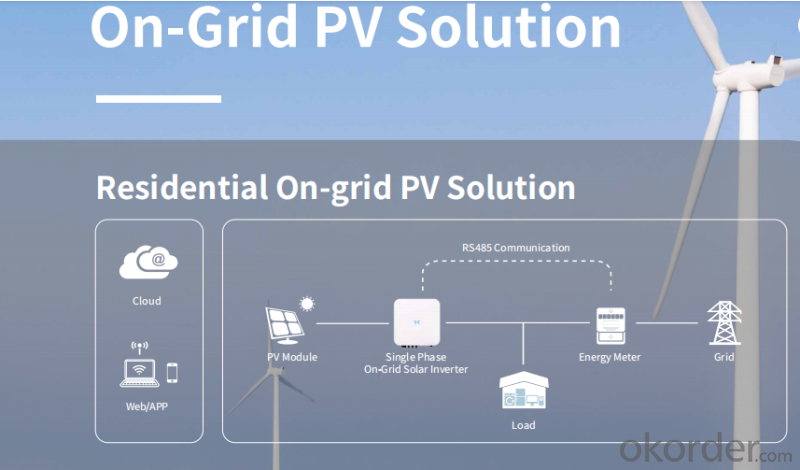
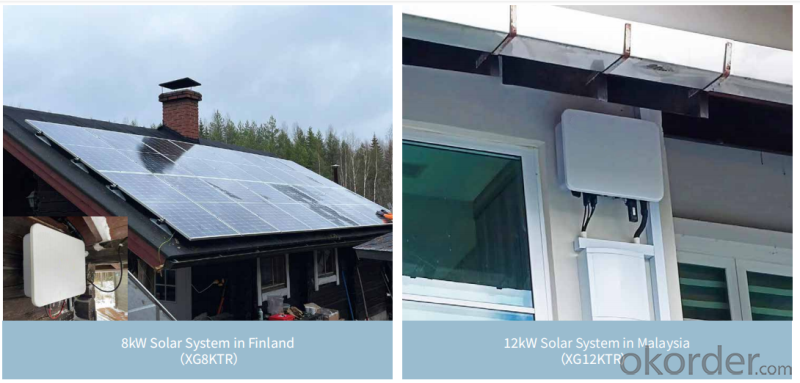


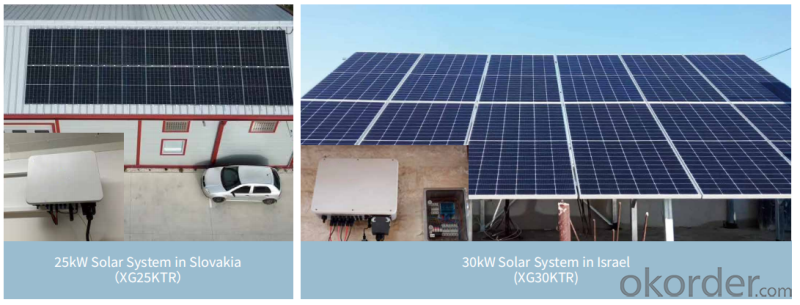
FAQ:
Q1:May I take some samples to test before placing the order ?
A1:Yes, welcome to take some sample to test!
Q2:How about the delivery time?
A2:7 days for sample; 25 days for bulk order.
Q3:What is the warranty of the controller?
A3:1 years warranty.
Q4:How to solve the technical problems?
A4:24 hours after-service consultancy just for you and to make your problem to be solved easily.
Q5:What payment methods do your company support?
A5:T/T, Western Union, Paypal, L/C etc.
Q6:What are the price terms can you offer for us?
A6:We can accept EXW, FOB, CIF and so on.
Q7:Do you have any certifications for your products?
A7:We have ISO9001:2000, CE, RoHS, certificates for all of our products.
- Q: What is the role of a solar inverter in preventing electrical faults?
- The role of a solar inverter in preventing electrical faults is to convert the direct current (DC) generated by solar panels into alternating current (AC) that can be used to power electrical devices. By regulating the voltage and frequency of the AC output, it ensures that the electrical power is stable and suitable for consumption. Additionally, solar inverters have built-in protective features such as ground fault protection, overvoltage protection, and short-circuit protection, which help detect and prevent electrical faults that may occur within the solar power system.
- Q: What is the role of a solar inverter in net metering?
- The role of a solar inverter in net metering is to convert the direct current (DC) electricity generated by solar panels into alternating current (AC) electricity that can be used to power household appliances or fed back into the electric grid. It ensures that the electricity produced by the solar panels is synchronized with the grid's voltage and frequency. Additionally, the solar inverter allows for the measurement and tracking of the energy generated and consumed, enabling accurate net metering calculations and billing.
- Q: Three-phase photovoltaic inverter grid, the use of phase-locked loop is what?
- Grid-connected inverter can be operated locally through the LCD screen, or through remote monitoring with dedicated monitoring software.
- Q: The working principle of photovoltaic grid - connected inverter
- Inverter will be converted into alternating current DC, if the DC voltage is low, then through the AC transformer boost, that is, the standard AC voltage and frequency. For large-capacity inverter, because the DC bus voltage is high, AC output generally does not require transformer boost that can reach 220V, in the small and medium capacity of the inverter, because the DC voltage is low, such as 12V, 24V, It is necessary to design a boost circuit.
- Q: How does a solar inverter convert DC to AC power?
- A solar inverter converts direct current (DC) power generated by solar panels into alternating current (AC) power that can be used to power appliances and feed into the electrical grid. It does this through a two-step process. Firstly, the DC power from the solar panels is converted into a high-frequency AC signal using power electronics. Then, this AC signal is transformed into the desired AC output voltage and frequency using pulse width modulation techniques. This allows for efficient and reliable conversion of solar energy into usable electricity.
- Q: What is the role of a solar inverter in reactive power compensation during grid disturbances?
- The role of a solar inverter in reactive power compensation during grid disturbances is to regulate and stabilize the flow of reactive power between the solar PV system and the grid. During grid disturbances, such as voltage fluctuations or power factor variations, the solar inverter can actively inject or absorb reactive power to maintain the voltage and power factor within acceptable limits. This helps in improving the overall stability and reliability of the grid system, ensuring efficient power transfer, and minimizing any adverse effects on the grid and connected electrical devices.
- Q: How does MPPT improve the efficiency of a solar inverter?
- MPPT, or Maximum Power Point Tracking, improves the efficiency of a solar inverter by constantly adjusting the operating point of the solar panel to extract maximum power from the sunlight. It ensures that the solar panel operates at its maximum power point, regardless of changing weather conditions or variations in the solar irradiance. This optimization leads to higher energy conversion efficiency, maximizing the power output of the solar panel and ultimately increasing the overall efficiency of the solar inverter.
- Q: Can a solar inverter be used with different types of energy storage systems?
- Yes, a solar inverter can be used with different types of energy storage systems. Solar inverters are typically designed to convert the direct current (DC) generated by solar panels into alternating current (AC) that can be used to power household appliances and other electrical devices. They can be integrated with various energy storage technologies such as batteries, supercapacitors, and flywheels to store excess energy generated by the solar panels for later use. The compatibility between the solar inverter and the energy storage system may depend on factors such as voltage requirements, capacity, and communication protocols.
- Q: Can a solar inverter be used with different types of energy management systems?
- Yes, a solar inverter can be used with different types of energy management systems. Solar inverters are designed to convert the direct current (DC) produced by solar panels into alternating current (AC) that can be used in various electrical systems. They can be integrated with different energy management systems, such as battery storage systems, smart grids, or even hybrid systems that combine solar power with other renewable energy sources. This flexibility allows for efficient and optimized utilization of solar energy in different setups and applications.
- Q: What is the role of a power factor controller in a solar inverter?
- The role of a power factor controller in a solar inverter is to regulate and optimize the power factor of the system. It ensures that the power factor remains close to unity, helping to improve the efficiency and performance of the solar inverter. By controlling the power factor, the controller minimizes reactive power generation and reduces energy losses, ultimately enhancing the overall power quality and stability of the solar inverter system.
Send your message to us
3kVA Solar Inverter - 50kw 60kw 66kw 70kw Three Phase On-Grid Solar Inverter
- Loading Port:
- SHENZHEN
- Payment Terms:
- TT OR LC
- Min Order Qty:
- 30 unit
- Supply Capability:
- 500 unit/month
OKorder Service Pledge
OKorder Financial Service
Similar products
Hot products
Hot Searches
Related keywords
